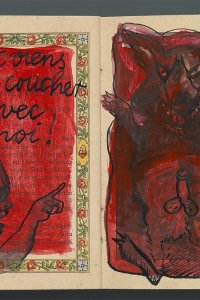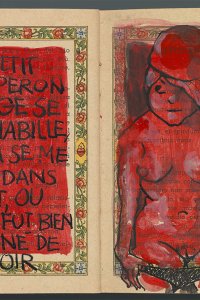Le petit chaperon rouge
Year: 2015
Author: Charles Perrault (1628 - 1703)
Artist: Burgi Kühnemann 1935
From devotion to eroticism
During one of her stays in Italy Burgi Kühnemann came across a devotional book, Nove uffizi in onore del Sacro Cuore di Gesù, published in 1952 and distributed by the Santuario Sacro Cuore Salesiani in Bologna. She went on to use the book as drawing paper for her handwritten version of the story of Little Red Riding Hood.
Originally conceived by Charles Perrault (1628-1703), in this version of events Little Red Riding Hood sets out with a pancake and butter for her grandmother, meets in the woods a wolf who subsequently runs ahead to the grandmother’s house, devours the poor woman, crawls into her bed and awaits the arrival of the little girl. When Little Red Riding Hood arrives the wolf asks her to get into bed with him – at this point Burgi’s illustrations become sexually explicit. We see an excited wolf and a nude Little Red Riding Hood. The girl does of course notice that her ‘grandmother’ has exceptionally large feet, hands, ears, eyes and teeth but the fact that ‘she’ has switched gender, has even become an animal and has a huge erection into the bargain all escape the child’s notice. She is gobbled up and the moral of the story is that charming wolves are the most dangerous kind.
The book’s opening pages, rendered in acrylics, black ink and Indian ink are colourful and even radiate glee, but the entire conversation with the wolf sections are drawn and written against a dark red background. The little devotional book has thus been transformed into a book of cartoons. This book is ‘packaged’ in textile, featuring an embroidered red riding hood. In the past, Kühnemann has also mounted and displayed books in small presentation cases. From that point of view the book does, at a first glance, seem perhaps more like a museum piece than an actual book.
Altered books, makeovers and biblioclasm
Since the turn of the century, it has become popular among artists to acquire and recycle old printed books. Instances of such work can be found in compilations and overviews such as* Book art. Iconic sculptures and installations made from books* (2011): books have pages and sections cut out, quires are folded to make them fan and lines of print are cut out and rearranged to form sculptures.
It is also the case that depictions are sometimes inserted into books or the pages are covered in paint. Examples of such kinds of work can be found in publications like The book as art (2007) and Art made from books (2013). In all these different sorts of art-driven book manipulations there is always a hint of ‘biblioclasm’, that is to say, the act of deliberately defacing or damaging a book; of simply covering it with graffiti-like doodles. Examples of this final category are presented in Kaba und Liebe (2006), where the familiar yellow, white and orange covers of the Reclam-school publications series devoted to the German literary classics can be seen: all thoroughly scribbled on by pupils.
What therefore strongly resonates in the work of Burgi is the sentiments of the biblioclast (the wilful destroyer of books), but one might also argue that in this way second-hand paper – derived from atlases, booklets, art reproductions, music scores, manuscripts – is simply being given a new lease of life. There is always a history, a story to tell, it is just that the original uses have become redundant. Since Burgi is interested in telling stories she finds it logical to use paper that has a past. Even the fairy tale she narrates anew undergoes a metamorphosis during the writing and drawing process. These old stories in new jackets inevitably comment, at some level, upon the books in which they nestle: superimposing the story of Little Red Riding Hood onto a devotional text somehow indirectly says something about the conceivable gullibility of the original religious reader. As Stefan Soltek once observed, in some of Burgi Kühnemann’s previous books productions, texts were completely painted over with the exception of certain words, thus lending those isolated words an almost ‘magical’ quality.
Not all books that come into Burgi’s hands are reworked with her brush, pencil or pen; she is also a fervent collector of old children’s books, such as alphabet books, and those books remain intact in her bookcases.
Bibliographical description
Description: Le petit Chaperon Rouge : conte de Charles Perrault / Perrault ; [illustrations et réalisation de] Burgi. - [Fini] : [Burgi Kühnemann], 2015. - 40 pages. : illustrations ; 12 cm
Printer: Not printed. Handwritten and decorated by Burgi Kühnemann
Edition: Unique copy, painted in a devotional book, 'Nove uffizi in onore del Sacro Cuore di Gesù', published by the Santuario Sacro Cuore Salesiani, Bologna, 1952
Note: Signed by the artist. In an embroidered red riding hood
Shelfmark: KW Koopm P 10062
References
- Paul van Capelleveen, 'Burgi Kühnemann', in: Artists & others. The imaginative French book in the 21st century. Koopman Collection, National Library of the Netherlands. Nijmegen, Vantilt Publishers, 2016, p. 166-169.
- [Stefan Soltek], Burgi Kühnemann. Buch-Akte. Frankfurt am Main, Museum für Kunsthandwerk, 1990


